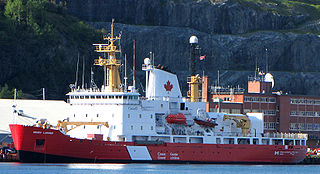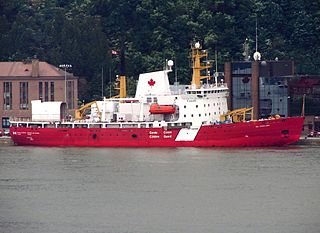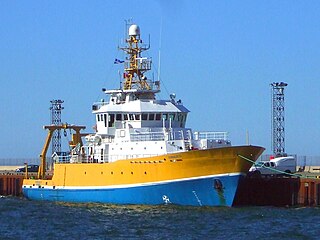
CCGS Henry Larsen is a Canadian Coast Guard Improved Pierre Radisson-class icebreaker serving in the Newfoundland and Labrador region and based in St John's, Newfoundland and Labrador. Entering service in 1988, Henry Larsen is the fourth ship and of an improved design over the rest of the ships in her class. The ship operates in the Arctic Ocean during summer months.

CCGS Samuel Risley is a Canadian Coast Guard icebreaker and buoy tender assigned to the Great Lakes area. Lead ship of her class, the vessel is named after the 19th century maritime inspector and first head of Board of Steamship Inspectors Samuel Risley for Upper Canada and Ontario. Based in the Great Lakes, CCGS Samuel Risley is responsible for keeping an ice-free passage between Port Colborne, Ontario and Thunder Bay, Ontario.

CCGS Labrador was a Wind-class icebreaker. First commissioned on 8 July 1954 as Her Majesty's Canadian Ship (HMCS) Labrador in the Royal Canadian Navy (RCN), Captain O.C.S. "Long Robbie" Robertson, GM, RCN, in command. She was transferred to the Department of Transport (DOT) on 22 November 1957, and re-designated Canadian Government Ship (CGS) Labrador. She was among the DOT fleet assigned to the nascent Canadian Coast Guard (CCG) when that organization was formed in 1962, and further re-designated Canadian Coast Guard Ship (CCGS) Labrador. Her career marked the beginning of the CCG's icebreaker operations which continue to this day. She extensively charted and documented the then-poorly-known Canadian Arctic, and as HMCS Labrador was the first ship to circumnavigate North America in a single voyage. The ship was taken out of service in 1987 and broken up for scrap in 1989.

CCGS Bartlett is a Provo Wallis-class buoy tender in operation by the Canadian Coast Guard. The vessel entered service in 1969 and was modernized in 1988. In 1982, the ship commanded the recovery efforts following the Ocean Ranger sinking off the coast of Newfoundland. The vessel is assigned to the Pacific Region and is based at Victoria, British Columbia.

CCGS Sir William Alexander is a Martha L. Black-class light icebreaker. Entering service in 1987, the vessel is currently assigned to CCG Maritimes Region and is homeported at CCG Base Dartmouth, in Dartmouth, Nova Scotia. The vessel is named after Scottish explorer Sir William Alexander, 1st Earl of Stirling, who was an early colonizer of Nova Scotia.

CCGS Des Groseilliers is a Pierre Radisson-class icebreaker in the Canadian Coast Guard. The vessel is named after Médard Chouart des Groseilliers (1618–1669) a close associate of Pierre-Esprit Radisson in explorations west of the Great Lakes and the founding of the British Hudson's Bay Company. The ship entered service in 1982. The vessel has participated in a number of research voyages, including Ice Station SHEBA. As part of the Surface Heat Budget of the Arctic Ocean experiment conducted in the Arctic Ocean from October 1997 to October 1998 to provide polar input to global climate models, Des Groseilliers was allowed to be frozen into the ice for the Arctic winter, to serve as a base for scientific researchers.

CCGS Hudson is an offshore oceanographic and hydrographic survey vessel operated by the Canadian Coast Guard. The ship entered service in 1963 with the Canadian Oceanographic Service, stationed at the Bedford Institute of Oceanography, called CSS Hudson. The ship made several significant scientific voyages, among them the first circumnavigation of the Americas in 1970. The ship was transferred to the Canadian Coast Guard in 1996 and remains in service.
CCGS Brant was a Canadian Coast Guard vessel in service between 1928 and 1966. Stationed on the East Coast of Canada, Brant was deployed as a navigation aids tender. Brant was the last coal-burning vessel in Canadian government service.
CCGS Tupper was a Canadian Coast Guard ice-strengthened buoy tender that served from 1959 to 1998. The vessel spent her entire career on the East Coast of Canada. Following her Canadian service, Tupper was sold to private interests with the intention of converting her to a yacht, but the conversion never happened and the vessel moved about Halifax Harbour, suffering a fire in 2008 before being sold for scrap in 2011.

CCGS Simcoe was a Canadian Coast Guard buoy tender and light icebreaker. The second vessel of the name in Canadian government service, Simcoe was in service from 1962 to 2007 based out of the Coast Guard base at Prescott, Ontario working the Great Lakes and Saint Lawrence Seaway. In 2008 the ship was sold to commercial interests.

Coriolis II is a Canadian research vessel. She is homeported in Rimouski, Quebec. She is operated by a consortium of five institutions: Institut des sciences de la mer à Rimouski (ISMER), the Université du Québec à Montréal (UQAM), McGill University, the Institut national de la recherche scientifique - Eau, terre et environnement (INRS-ETE) and the Maurice Lamontagne Institute (MLI-DFO). The vessel was constructed in 1990 by Versatile Pacific Shipyards of Esquimalt, British Columbia for the Canadian Coast Guard. Initially named CCGS John Jacobson, the vessel was deployed for search and rescue missions along Canada's coastlines. The Canadian Coast Guard took John Jacobson out of service in 1999 and sold the ship to her current owners in 2001.

CCGS Pierre Radisson is the lead ship of her class of icebreakers. Constructed and operated by the Canadian Coast Guard, the vessel is based at Quebec City on the Saint Lawrence River. The ship was constructed in British Columbia in the 1970s and has been in service ever since. The vessel is named for Pierre-Esprit Radisson, a 17th-century French fur trader and explorer.
CCGS Earl Grey is a Samuel Risley-class light icebreaker and buoy tender in the Canadian Coast Guard. Constructed in 1986, the vessel serves a variety of roles, including light ice-breaking and buoy tending, as well as being strengthened for navigation in ice to perform tasking along the shores off the Atlantic coast of Canada. Like her sister ship, CCGS Samuel Risley, she carries a large and powerful crane on her long low afterdeck for manipulating buoys. Earl Grey is the second icebreaker in Canadian service to carry the name.

CCGS Martha L. Black is the lead ship of her class of light icebreakers of the Canadian Coast Guard. The ship was built in 1986 in Vancouver, British Columbia by Versatile Pacific Shipyards Limited as part of the CG Program Vessels. The vessel was mainly designed as a high-endurance, multi-tasked boat. Most of her duties are along the St. Lawrence River and St. Lawrence Seaway as she is able to handle the ice thickness there.

CCGS Edward Cornwallis is a Martha L. Black-class icebreaker of the Canadian Coast Guard. She serves as a light Icebreaker and buoy tender on the East Coast of Canada. Entering service in 1986, the vessel is homeported at Dartmouth, Nova Scotia. The vessel is named after Lieutenant General Edward Cornwallis, a British Army officer and founder of Halifax, Nova Scotia.
CCGS Provo Wallis is a Provo Wallis-class buoy tender that served with the Canadian Coast Guard. The vessel entered service in 1969 and was classed as a Medium-endurance Multi-tasked Vessel. Provo Wallis spent the majority of her career on the Atlantic Coast of Canada before transferring to the West Coast. Ice-strengthened, the ship was used mainly for maintaining navaids in shipping lanes. The vessel was taken out of service in 2011 and laid up.

CCGS Matthew was a Canadian Coast Guard mid-shore scientific research and survey vessel, based at Dartmouth, Nova Scotia, that entered service in 1990. The ship operated within the Canadian Coast Guard Maritimes region. Matthew was primarily used to carry out hydrographic survey work primarily for the production of nautical charting products on the East and West Coasts, but could also be used for stock assessment using sonar. In 2016, the ship was taken out of service and put up for sale. Two years later a bid for $279,000 was accepted by the Canadian government and is currently in transition of new ownership.

The Samuel Risley-class icebreakers are a class of two icebreakers and buoy tenders constructed for and operated by the Canadian Coast Guard. The two ships are based on offshore supply tugboat design and entered service in the 1980s. Samuel Risley is deployed to the Central Region, operating mainly on the Great Lakes of North America while Earl Grey is posted to Atlantic Canada, working off the east coast of Canada.

CCGS Tanu is a fisheries patrol vessel in service with the Canadian Coast Guard. The ship was constructed in 1968 by Yarrows at their yard in Esquimalt, British Columbia and entered service the same year. Home ported at Patricia Bay, British Columbia, the ship is primarily used to carry out fisheries patrols and search and rescue missions along Canada's Pacific coast.

The Pierre Radisson-class icebreakers, also known as R-class icebreakers, are a class of four icebreakers constructed for and operated by the Canadian Coast Guard. The Canadian Coast Guard designates the four ships in the class as medium icebreakers. Built in two phases, the first three ships, Pierre Radisson, Franklin and Des Groseilliers, were built to a common design. The fourth, Henry Larsen was built to a modified design and is considered a subclass, the Improved R-class icebreaker. Franklin was later renamed Sir John Franklin before undergoing a re-design for use primarily as an Arctic research vessel. Upon the vessel's return to service, the ship was once again renamed Amundsen. All the vessels are named for people who sailed through Canada's northern waters. The class operates in the Arctic Ocean in the summer, patrolling, icebreaking and research missions.














